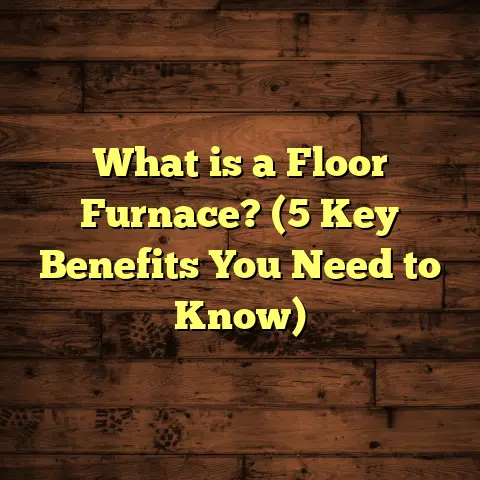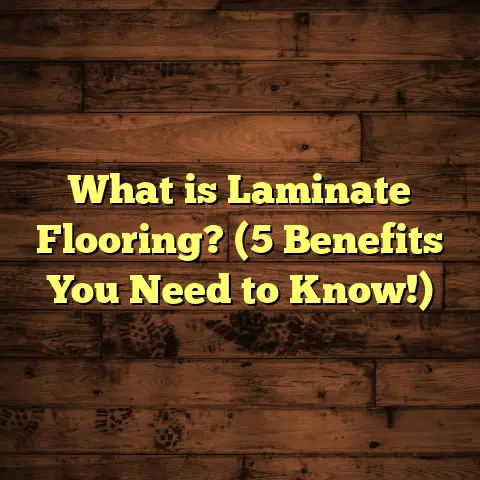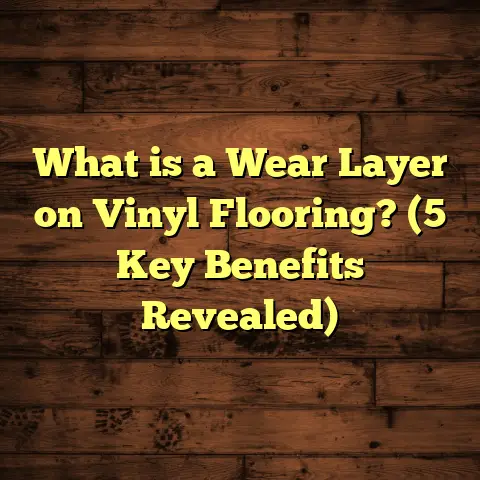What is a Floor Protector? (5 Key Benefits for Your Floors)
I’ve always been pretty particular about my floors. Not just how they look but how well they hold up over time. If you’re anything like me, you probably want floors that stay beautiful for years, even when life gets a little hectic—kids running around, pets scratching, furniture moving, spills here and there. That’s why I want to talk about something I think a lot of people overlook but is super important: the floor protector. Using floor protectors has genuinely saved me time, money, and frustration. So, let’s take a good look at what they are and why they’re worth adding to your home.
What is a Floor Protector?
At its simplest, a floor protector is any product or material designed to shield your floors from damage. This might sound broad—and it is—but those simple protections are often what make the biggest difference. It can be as basic as felt pads stuck to the bottom of chair legs or rubber mats placed under heavy furniture. It can also be specialized plastic films laid down during renovations or protective coatings applied to certain floor types.
When I first heard about floor protectors, I imagined bulky mats or expensive coatings only used in commercial spaces. But after accidentally scratching my hardwood floors by dragging a chair, I started exploring different types of protectors. What I found surprised me: these products are affordable, easy to use, and incredibly effective.
Here’s something interesting: flooring damage from everyday activities like moving furniture or even walking in with shoes accounts for a huge part of wear and tear in homes. A study by the National Floor Safety Institute revealed that about 40% of home floor damage stems from furniture movement and foot traffic. That’s a lot!
Floor protectors come in many forms:
- Furniture pads: Felt or rubber pads attached to legs of chairs, tables, sofas.
- Floor mats: Placed in high-traffic areas or entryways to catch dirt and moisture.
- Plastic films: Temporary coverings during home renovations.
- Coatings: Liquid sealants or finishes that add a protective layer.
- Rugs and runners: Strategically placed to absorb impact and dirt.
Each serves a specific purpose but shares one goal: protecting your floors from damage.
Why Should You Care About Floor Protection?
If you’ve ever seen scratches on hardwood or stains on tile and thought “Oh well, we’ll live with it,” you might want to reconsider. Floors are an investment. Whether you have pricey hardwood or durable vinyl, protecting them extends their life, saving you from costly repairs or replacements down the road.
I learned this the hard way after installing laminate floors in my home office. I didn’t use any protective pads on my rolling chair at first, and within months, there were noticeable grooves forming. Adding plastic floor protectors under the chair wheels stopped any further damage immediately.
Let’s explore five key benefits of floor protectors in detail so you know exactly why they’re worth your attention.
1. Protects Against Physical Damage
This one is probably the most obvious benefit, but it’s also the most important.
Every day, our floors face threats from sharp objects, heavy furniture, pets’ claws, and just regular foot traffic. Moving furniture without protection can cause scratches or dents that ruin the look of even the highest-quality floors.
Think about the last time you pulled out a chair at the dining table. Did you feel that scrape? Felt pads under chair legs can reduce friction dramatically. I use thick felt pads on all my dining chairs—they’re cheap but make pulling chairs out quiet and smooth while protecting my hardwood from scratches.
Pets are another common source of damage. Dogs and cats can be playful but their nails act like tiny knives on wood or laminate surfaces. I have two energetic dogs who love running around the house. Installing rubber-backed area rugs in their favorite spots has helped absorb some of the impact and protected my floors from constant wear.
A 2022 report from the Flooring Industry Association showed that homes with active pets report 25% more flooring repairs annually than those without pets. Adding protective mats or pads can reduce this by up to 60%.
Types of Physical Floor Damage Prevented
- Scratches: Caused by dragging furniture or pet claws.
- Dents: Heavy furniture legs pressing into softwoods like pine.
- Scuffs: From rubber soles or wheels.
- Chips: Sharp objects dropped on tile or hardwood.
Using floor protectors minimizes these issues by acting as a barrier between your floor and potential hazards.
My Personal Experience
I once hosted a family gathering where several heavy chairs were stacked in one corner temporarily. I hadn’t put any floor protectors on them because I thought it would only be for an hour or two. Big mistake! By the next day, there were deep impressions in my hardwood floor that took weeks to buff out professionally.
Since then, I never move furniture without felt pads under legs or a protective mat underneath. It’s such a simple step that saves so much trouble.
2. Helps Prevent Stains and Moisture Damage
Moisture is one of the biggest enemies of many flooring types—especially hardwood and laminate. Water seeps in and causes warping, swelling, or staining that can ruin your floors quickly if not managed properly.
Floor protectors come into play here with mats placed near entrances or under plants to catch spills before they reach sensitive flooring. I remember during one rainy season when water was tracked inside every day after walks with my dogs. I installed thick mats at all entryways and under indoor plants—this small change kept my laminate floors dry and prevented water stains.
According to research by the Hardwood Flooring Manufacturers Association, moisture-related damage accounts for nearly 30% of premature hardwood floor failures in residential homes. That’s a significant chunk!
How Floor Protectors Help with Moisture
- Absorb moisture: Mats soak up water droplets before they reach your floor.
- Create barriers: Plastic films and coatings repel liquids.
- Prevent dirt buildup: Mats trap dirt mixed with moisture from shoes.
- Reduce slipping hazards: Some mats also have slip-resistant surfaces for safety.
Case Study: Plant Lovers Beware
A friend of mine used to have numerous indoor plants placed directly on her wooden floors without any protection underneath. Over time, water seeped through spilled watering sessions causing discoloration and warping around pots.
After switching to waterproof plant trays with built-in mats underneath, her floors stayed spotless despite her green thumb adventures.
3. Makes Cleaning and Maintenance Easier
Let’s be honest—cleaning floors can be a chore if dirt and grime spread everywhere. But floor protectors can make your life easier by limiting where dirt accumulates.
Placing washable mats at high-traffic points like kitchen sinks or doorways concentrates dirt in manageable areas that can be cleaned separately rather than scrubbing entire rooms constantly.
I have washable mats under my desk chair and near kitchen counters where spills are common. It means less sweeping and mopping across the whole room—just spot cleaning these mats saves so much time.
Also, some plastic or vinyl floor protectors designed for offices allow easy wiping instead of scrubbing hardwood repeatedly which reduces wear from aggressive cleaning agents.
Data on Cleaning Benefits
According to a 2023 survey by HomeCare Research Group:
- Homes using entryway mats report 35% less dirt tracked inside.
- Cleaning time reduces by an average of 20 minutes per week with strategically placed floor protectors.
- Proper use of floor protectors extends the time between professional deep cleaning by over 6 months on average.
Tips for Easier Floor Maintenance
- Use washable mats near entrances.
- Place plastic films during messy renovations.
- Use felt pads to prevent dirt accumulation under furniture.
- Regularly clean protective mats to avoid buildup.
4. Extends the Life of Your Flooring Investment
Floors are expensive! Whether you installed hardwood for $8–$12 per square foot or opted for budget-friendly vinyl at $2–$5 per square foot, protecting that investment means less money spent on repairs or replacement later on.
I remember when I renovated my living room with laminate flooring costing around $6 per square foot including installation. At first, I skipped buying protective caster cups for my office chair wheels to save money. That decision backfired because noticeable grooves appeared within months requiring costly repairs.
Industry data shows that well-maintained floors using protective solutions can last 20–30% longer than unprotected ones (Flooring Industry Association). Over a 10-year period, this translates into thousands saved on maintenance alone.
How Floor Protectors Extend Flooring Life
- Minimize scratches and dents that weaken surface integrity.
- Prevent moisture damage that leads to warping.
- Reduce need for harsh cleaning chemicals that degrade finishes.
- Distribute weight evenly under heavy furniture to avoid pressure points.
My Renovation Story
During a recent home renovation, I applied plastic films over new hardwood before painting walls and moving furniture around. The floors stayed flawless throughout the process despite heavy foot traffic and occasional spills. Without that protection, the finish would have suffered irreversible stains and scratches.
5. Enhances Safety and Comfort
Here’s something you might not think about immediately: floor protectors also improve safety and comfort at home.
Standing on hard floors for long periods can be tiring—especially in kitchens or workshops where you spend hours cooking or working on projects. Soft cushioned mats reduce fatigue by absorbing some pressure from your feet.
Likewise, slip-resistant mats cut down fall risks on slippery surfaces like tile or polished wood where water or spills happen frequently.
Having kids or elderly family members makes this even more important. Adding soft rugs or rubber-backed mats provides both cushioning and grip which means fewer accidents around the house.
Safety Data You Should Know
The CDC reports that falls are the leading cause of injury among older adults in the U.S., with many accidents occurring on slippery floors at home. Using slip-resistant mats has been shown to reduce fall risk by up to 40%.
My sister installed non-slip mats near her bathtub after her mother slipped once; it gave her peace of mind knowing her mom was safer moving around wet tiles.
More Details About Different Types of Floor Protectors
Let me break down some common types of floor protectors you might consider depending on your floor type and needs:
Felt Pads
These are my go-to for furniture legs because they’re inexpensive and easy to apply.
- Best for hardwood and laminate.
- Available in various thicknesses; thicker pads offer better cushioning.
- Need regular replacement as they wear out with use.
I keep a pack handy at home because I’m always swapping out old pads before they start scratching floors again.
Rubber Caps and Cups
These fit over furniture legs and are great for heavier items like sofas or tables.
- Provide excellent grip preventing sliding.
- Protect against dents by distributing weight evenly.
- Ideal for tile and vinyl floors where scratches are less common but dents happen.
I use these under my coffee table because it’s heavy and sometimes moved during cleaning days.
Plastic Films
Used mostly during renovations for temporary protection.
- Transparent sheets that cover entire rooms.
- Prevent paint splatters, dust infiltration, and moisture exposure.
For my last kitchen makeover, applying plastic film saved me thousands in potential refinishing costs later.
Mats and Rugs
Not just decorative but functional in protecting floors from dirt and moisture.
- Entryway mats trap debris before it reaches the house interior.
- Kitchen mats absorb spills near sinks.
- Area rugs cushion high-use zones like living rooms.
I recommend washable options so you can keep them clean easily without harming the floor underneath.
How To Choose The Right Floor Protector For Your Home
Picking the right protector depends on several factors:
What Type of Flooring Do You Have?
Hardwood requires soft felt pads; tile can handle rubber caps; laminate needs moisture protection too—each material has specific needs based on hardness and finish resilience.
Where Will It Be Used?
High traffic areas benefit from durable mats; furniture needs pads; renovation phases call for plastic films; wet zones require water-resistant options.
How Much Traffic Does The Area See?
Busy family rooms need thick cushions; rarely used guest rooms might only need basic protection.
Budget Considerations
There are options at every price point—from budget felt pads costing just cents each to premium anti-slip rugs priced higher but lasting longer.
Common Myths About Floor Protectors
I’ve heard plenty of misconceptions over the years:
Myth #1: Floor protectors are expensive
Actually, many options cost just a few dollars but save hundreds in repairs later.
Myth #2: They ruin the look of my floors
Good quality protectors are discreet—felt pads are barely noticeable; clear plastic films blend right in; stylish rugs add design value too!
Myth #3: They’re hard to install
Most protectors come with peel-and-stick backing or simple placement—no special tools needed!
Frequently Asked Questions (FAQs)
Do floor protectors damage floors?
No, if chosen correctly for your floor type and maintained properly, they prevent damage rather than cause it.
How often should I replace felt pads?
Typically every 6–12 months depending on use; replace when pads become compressed or dirty to avoid scratches.
Can I use rugs as floor protectors?
Absolutely! Area rugs protect large sections but remember to clean underneath regularly to prevent dirt buildup causing abrasion.
Are there eco-friendly options available?
Yes! Many manufacturers now offer recycled materials for mats and pads—check labels if sustainability matters to you.
Final Thoughts From My Flooring Journey
Taking care of floors is often an afterthought until damage shows up unexpectedly. But trust me when I say incorporating floor protectors into your home routine is one of the easiest ways to keep things looking great for years.
From felt pads under chairs to durable mats at doorways—and even temporary plastic films during renovations—these small investments pay off big time in preserving your flooring’s beauty and structural integrity.
Plus, tools like FloorTally made planning my recent projects so much smoother by helping me estimate costs including protective accessories—saving me money and headaches!
If you ever wonder whether adding some form of protection matters—it really does. Your floors will thank you with fewer scratches, stains, repairs, and much happier feet walking over surfaces that stay comfortable and safe longer.
So next time you move a chair, bring in new furniture, or tackle home updates—remember that simple floor protector could be your best friend in keeping your home looking fantastic without breaking your budget or losing sleep over damages!





